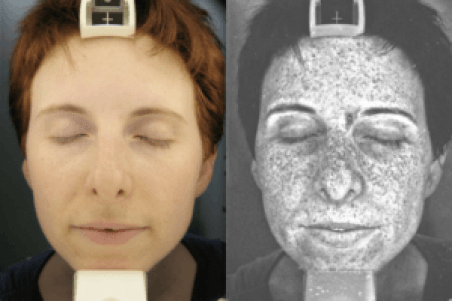3 Crazy UV Ray Facts You Might Not Know

It can be difficult to see the effects of UV radiation, but that doesn't mean that they aren't there. As you can see from the main image on our blog, UV exposure does cause skin damage over time, and is responsible for skin cancer and melanoma.
To help educate you and keep you sun safe, we decided to go over 3 crazy UV facts you might not know on our blog.
1. New Technology Now Uncovers Hidden UV Skin Damage
Most of us are familiar with sunburns and the painful effects of getting too much sun at one time, but new UV camera technology makes it possible for us to see the shocking extent of UV exposure and how it affects our skin.

As you age, the damage the sun causes to your skin accumulates over time, and the risk of developing skin cancer dramatically increases as you continue to get more UV exposure.
Just because the damage can’t be seen, doesn’t mean it is not present and potentially posing a serious threat to your health.
Other areas of the body are routinely exposed to UV radiation on a daily basis, but this type of damage can be prevented with UV Skinz's UV-blocking clothing.

Sadly, the new technology behind the UV-exposure photos have revealed skin damage in children as young as 2 years old!
Aside from the increased risk of skin cancer, sun damage prematurely ages your skin and robs it of its vitality.
2. Recent Study Proves 67% of Sunscreens FAIL to Protect Users
Although sunscreen can help protect your skin from the sun, many sunscreens do not provide the protection they claim.
A new study published in the Environmental Working Group’s 12th annual Sunscreen Guide found an alarming 67% of the sunscreen products that were tested failed to shield out harmful UV radiation!

In addition to this, many sunscreens contain harmful chemicals which are detrimental to both your health and the environment. Oxybenzone, a chemical found in most sunscreens, has been linked to causing hormone disruptions in humans and damaging the development of coral reefs around the world.
For these reasons, it is best to protect and cover your skin with UV-protective swimwear and clothing as much as possible.
3. Cloudy or Not UV Exposure Happens 365 Days a Year
Let’s be honest, thinking about sun protection is mostly something we do on hot and sunny days.
However, The Skin Cancer Foundation has found that up to 80% of the ultraviolet (UV) rays produced by the sun are able to pass through cloud-cover and still cause harm your skin!
Outside temperatures also have very little effect on UV radiation exposure. This is why it’s still possible to get sunburned while outside on cold and overcast days.
So it doesn’t matter if it’s cloudy or sunny, winter or summer, protecting your skin is something you need to think about DAILY.
In addition to passing easily through clouds, harmful UV radiation can also penetrate through most windows. Windows typically only block out one kind of UV radiation, short-wave UVB rays.
Long-wave UVA rays, which are able to penetrate deeper through surfaces, are able to pass through most windows and still harm your skin. This makes sun protection that much more important, even when you may not be completely outside (like when you are driving in a car).

Although high energy UVB rays are more responsible for burning the top layers of skin, it is the deeply penetrating UVA rays that cause the most damage and increase the risk of developing skin cancer.
Unfortunately, UVA rays are more able to pass through clouds, windows, and non-UV protective clothing.
How to Keep Yourself Safe from UV Exposure
The best way to keep yourself safe from UV exposure is by wearing UPF 50+ swimwear and clothing, staying out of the sun during peak UV index hours, and wearing a broad-spectrum, SPF 30+ sunscreen that's trusted.
Check out our collection of UPF 50+ swimwear and clothing online today for some inspiration.







